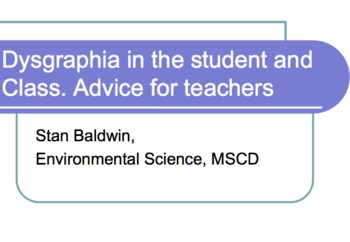Disgraphia & Handwriting Problems in the Class
3D-PT
125 Followers
Grade Levels
Higher Education, Adult Education, Homeschool, Staff
Resource Type
Standards
CCSSSL.6.1
CCSSSL.6.1a
CCSSSL.6.5
CCSSCCRA.SL.1
CCSSCCRA.SL.2
Formats Included
- PPT
Pages
47 pages
3D-PT
125 Followers
Also included in
- As a teacher I know we want to do everything possible to meet our legal obligations to our students. As a teacher with Autism, I know that teachers struggled with meeting my own unique needs. This bundle was created as part of my college studies, but also includes resources to help you in the classrPrice $52.51Original Price $58.35Save $5.84
Description
Disgraphia is the learning & physical disability related to handwritten output.
As a teacher with disgraphia, I had to grow up learning how to accommodate myself and be my own self-advocate. Your struggling students are facing many issues in schools that still rely on hand-written work.
Today in class I struggle with teaching and student understanding my handwriting.
This presentation has an activity you can use to role play a students struggles, and describes disgraphia from my point of view.
This presentation also covers social issues and bullying related to disgraphia.
Keywords: Disgraphia, handwriting, SpEd, special education, bullying, social skills, teacher, students, activity, role play, powerpoint.
Total Pages
47 pages
Answer Key
N/A
Teaching Duration
N/A
Report this resource to TPT
Reported resources will be reviewed by our team. Report this resource to let us know if this resource violates TPT’s content guidelines.
Standards
to see state-specific standards (only available in the US).
CCSSSL.6.1
Engage effectively in a range of collaborative discussions (one-on-one, in groups, and teacher-led) with diverse partners on grade 6 topics, texts, and issues, building on others’ ideas and expressing their own clearly.
CCSSSL.6.1a
Come to discussions prepared, having read or studied required material; explicitly draw on that preparation by referring to evidence on the topic, text, or issue to probe and reflect on ideas under discussion.
CCSSSL.6.5
Include multimedia components (e.g., graphics, images, music, sound) and visual displays in presentations to clarify information.
CCSSCCRA.SL.1
Prepare for and participate effectively in a range of conversations and collaborations with diverse partners, building on others’ ideas and expressing their own clearly and persuasively.
CCSSCCRA.SL.2
Integrate and evaluate information presented in diverse media and formats, including visually, quantitatively, and orally.






